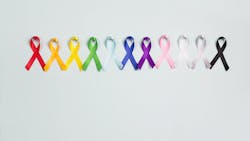Antineoplastic agents and their oral adverse effect
Editor's note: This is part one of two-part series. Read part two here.
Most of us know someone who has or had cancer. In order to prolong the length and quality of life of those with this disease, therapy with antineoplastic agents, if indicated, should be initiated as soon as possible.
While antineoplastic agents are toxic to cancer cells, they may also be toxic to normal, rapidly dividing cells. For example, the cells that make up the mucosal lining of the gastrointestinal tract, as well as the cells that make up the hair follicles, are prime targets for antineoplastic agent-related toxicity due to their rapid rate of cell turnover. Thus, typical adverse effects of chemotherapy include nausea, vomiting, and hair loss.
How cancer affects the oral environment
The mouth is also a prime target for the adverse effects of antineoplastic agent therapy. Antineoplastic agents interfere with cell growth in the lining of the mouth, slowing the ability of oral tissue to repair itself. This leads to an array of oral complications that can seriously compromise a patient’s health and quality of life.
In the first of this two-part article on the adverse oral effects of antineoplastic agent therapy, I will focus on one of the most devastating complications from such therapy—oral mucositis. This can become so severe that a patient may elect to receive lower doses of therapy, postpone therapy, or discontinue therapy entirely.
More by Tom Viola
Weed my lips: The good and not-so-good aspects of cannabis use among patients
When is your appointment with your hygienist? Dental care during cancer treatment is pivotal
We know that preexisting oral disease has long been associated with increased incidence and severity of oral complications related to antineoplastic agents, especially oral mucositis. Necessary dental treatment and proper oral hygiene before, during, and after therapy can reduce the incidence and severity of these oral complications.
Unfortunately, many cancer patients and their families are not aware that antineoplastic agents may affect the oral tissues and that visiting their dental hygienist is an important part of their overall treatment. Therefore, many cancer patients do not seek care until oral complications, such as oral mucositis, have already developed.
Normal oral mucosa cells undergo complete replacement approximately every 10 days. In addition, normal salivary gland function promotes mucosal health through multiple mechanisms. Antineoplastic agents directly impair the replication of oral mucosa cells and the function of the salivary glands.
Ulcerative oral mucositis occurs in approximately 40% of patients receiving antineoplastic agent therapy. Mucositis emerges within two weeks after therapy is initiated and is usually severe. It often requires medical intervention, including the interruption of antineoplastic agent therapy.
Oral mucositis factors
The type of antineoplastic agent employed affects the probability of oral mucositis. Antineoplastic agents that commonly cause oral mucositis are doxorubicin, bleomycin, fluorouracil, methotrexate and etoposide.1 Drugs such as methotrexate and etoposide are secreted in saliva, which favors oral toxicity.2
Risk factors for developing oral mucositis also include a patient’s age, preexisting malnutrition, poor oral health, and liver and kidney disease. Periodontal disease increases the risk of oral mucositis. Pathogens such as Porphyromonas gingivalis seem to be responsible for promoting ulceration and mucositis.3
Oral mucositis may be complicated by infection with opportunistic bacterial pathogens, especially if the patient is immunocompromised. Periapical infections often proliferate, and previously asymptomatic teeth may suddenly show symptoms of infection during antineoplastic therapy.4
Another consideration is that during mucositis, organisms such as Streptococcus viridans may easily spread systemically. This may result in bacteremia and potentially life-threatening septic infection, especially if the patient is immunocompromised.5
Fungal infection is also common during oral mucositis, especially with Candida and Aspergillus species.6 Pseudomembranous and erythematous candidiasis may result in dysgeusia and xerostomia, burning sensations, and overall oral discomfort.7
In addition to bacterial and fungal infections, patients receiving chemotherapy and radiation are at risk for viral infections, including herpes simplex virus and varicella-zoster virus. Since these infections are often the result of reactivation of an existing virus, prophylaxis with antiviral medications may reduce the incidence of infection.8
Unfortunately, the use of antibacterials to treat secondary bacterial infections may create a favorable environment for fungal infection. Also, treatment of secondary fungal and viral infections may be complicated by potential drug interactions with antineoplastic agents.
The healing process
When not complicated by infection, mucositis typically heals within two to four weeks after cessation of antineoplastic agent therapy. Meticulous oral hygiene is essential. Oral rinses with chlorhexidine and atraumatic mechanical plaque removal, including brushing and flossing, are usually recommended but may not be effective. Management of oral mucositis via topical approaches includes the use of bland rinses (saline and/or sodium bicarbonate solutions), mucosal coating agents (antacid solutions), and water-soluble lubricating agents for xerostomia (artificial saliva).
Systemic antibacterials, such as amoxicillin, are often used to treat bacterial infections. Topical oral antifungal agents, such as nystatin, are often employed but may have limited efficacy. Systemic agents, such as fluconazole, should be used for persistent fungal infections, especially if the patient is immunocompromised.
If topical anesthetics such as lidocaine are not sufficient to relieve pain, systemic analgesics are employed. Opioid analgesics are typically used in patients receiving chemotherapy since nonsteroidal anti-inflammatory drugs (NSAIDs) may affect platelet aggregation, which increases the risk of bleeding and may directly damage gastric mucosa.
Most of us know someone whose life has been affected by cancer. Since many cancer patients are not aware that antineoplastic agent therapy can affect their oral tissues, dental hygienists are invaluable in managing and preventing the oral complications of these agents. In part two, I will explore other adverse oral effects of antineoplastic agent therapy and more opportunities for dental hygienists to maintain and improve their patients’ quality of life.
Editor's note: This article appeared in the April 2022 print edition of RDH magazine and has been updated as of February 2025. Dental hygienists in North America are eligible for a complimentary print subscription. Sign up here.
References
- Nape-as JJ, Brennan MT, Bahrani-Mougeot FK, Fox PC, Lockhart PB. Relationship between mucositis and changes in oral microflora during cancer chemotherapy. Oral Surg Oral Pathol Oral Radiol Endod. 2007;103(1):48-59. doi:10.1016/j.tripleo.2005.12.016
- Chavelli-Lopez B, Bagan-Sebastian JV. Treatment of oral mucositis due to chemotherapy. J Clin Exp Dent. 2016;8(2):e201-e209. doi:4317/jced.52917
- Al-Ansari S, Zecha JA, Barasch A, de Lange J, Rozema FR, Raber-Durlacher JE. Oral mucositis induced by anticancer therapies. Curr Oral Health Rep. 2015;2(4):202-211. doi:1007/s40496-015-0069-4
- Raber-Durlacher JE, Epstein JB, Raber J, van Dissel JT, van Winkelhoff AJ, Guiot HF, van der Velden U. Periodontal infection in patients treated with high-dose chemotherapy. Support Care Cancer. 2002;10(6):466-473. doi:1007/s00520-002-0346-3
- Lark RL, McNeil SA, VanderHyde K, Noorani Z, Uberti J, Chenoweth C. Risk factors for anaerobic bloodstream infections in bone marrow transplant recipients. Clin Infect Dis. 2001;33(3):338-343. doi:1086/322595
- Maheronnaghsh M, Tolouei S, Dehghan P, Chadeganipour M, Yazdi M. Identification of Candida species in patients with oral lesion undergoing chemotherapy along with minimum inhibitory concentration to fluconazole. Adv Biomed Res. 2016;5(8):132. doi:4103/2277-9175.187394
- Li XS, Sun JN, Okamoto-Shibayama K, Edgerton M. Candida albicans cell wall ssa proteins bind and facilitate import of salivary histatin 5 required for toxicity. J Biol Chem. 2006;281(8):22453-22463. doi:10.1074/jbc.M604064200
- Lopez BC, Esteve CG, Perez MGS. Dental treatment considerations in the chemotherapy patient. J Clin Exp Dent 2010;3(1):31-42. doi:10.4317/jced.3.e31
About the Author

Tom Viola, RPh, CCP
With more than 30 years’ experience as a board-certified pharmacist, clinical educator, professional speaker, and published author, Tom Viola, RPh, CCP, has earned the reputation as the go-to specialist for making pharmacology practical and useful for dental teams. He is the founder of Pharmacology Declassified and is a member of the faculty of more than 10 dental professional degree programs. Viola has contributed to several professional journals and pharmacology textbooks, and currently serves as a consultant to the American Dental Association’s Council on Scientific Affairs.
